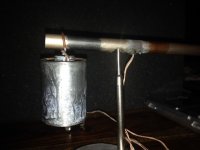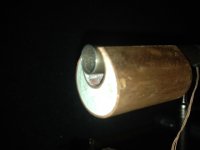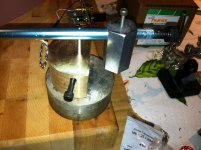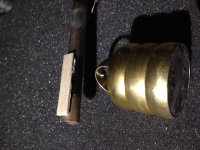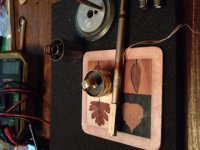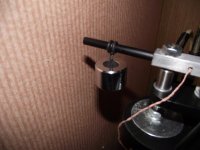hi guys...
Stew, any info on that RD11s motor?/QUOTE]
Moray: Any good 300rpm motor will do. The Hurst motors are similar to the Premotec/Thompson/Airpax, and are half the price. (look for LYD35115D, it comes with the correct capacitors, and has at least as much torque). You may have to make a small adapter (or elongate the mounting holes @ the 7:30 position)...the stock motors have amounting ears at 60.2 mm spacing.
Jay: I took a stab at making a Roksan intelligent counter-weight. and didn't like the B.S required to get the thing to work correctly. The knotted counter-weight works good and has enough grip to allow adjustment of the cartridge azimuth. Not mechanically elegant, but oh so easy and very effective.
I've thought of another way to accomplish the same thing as the Roksan counter-weight, but need to make it.
The elegant C/weight was much to light, so will look at something different.
The Roksan C/w seems relatively simple but as you say not very elegant.
I'd be inclined to replace that ugly screw on the top with a simple tiny cone inside or a ball from a pen, like 219 bearing. Theirs no need for any adjustment hear.
It will be interesting to see what you come up with.
The Linn went POP so It will be a while before its sorted now.
The Roksan C/w seems relatively simple but as you say not very elegant.
I'd be inclined to replace that ugly screw on the top with a simple tiny cone inside or a ball from a pen, like 219 bearing. Theirs no need for any adjustment hear.
It will be interesting to see what you come up with.
The Linn went POP so It will be a while before its sorted now.
A more elegant counter-weight...
Jay and others:
One thing that must be addressed if trying to create something like the Roksan intelligent counter-weight is the need for an adjustment for azimuth. If the headshell can be rotated when inserted into the arm tube and then secured tight with a screw, then that would work. Then, the use of a male bearing would work well. All that would be needed is to make a dimple in the arm tube, or else create a trough along the rear end of the arm tube. That would give a location for the pen nub or male bearing to set into.
Jay and others:
One thing that must be addressed if trying to create something like the Roksan intelligent counter-weight is the need for an adjustment for azimuth. If the headshell can be rotated when inserted into the arm tube and then secured tight with a screw, then that would work. Then, the use of a male bearing would work well. All that would be needed is to make a dimple in the arm tube, or else create a trough along the rear end of the arm tube. That would give a location for the pen nub or male bearing to set into.
Stew:I
If like most of us the head shell is fairly well fixed now. Then a little extra work is needed.
So for bias compensation with a uni-pivot C/weight (Stew i'm not going to use the term Intelligent C/w cos thats just Roksan BS) why not something like a paperclip opened out & re shaped to form a triangle with a small weight that can slide along the base of said triangle !.... or an inverted T that could have the weight/s either side.
Jay
If like most of us the head shell is fairly well fixed now. Then a little extra work is needed.
So for bias compensation with a uni-pivot C/weight (Stew i'm not going to use the term Intelligent C/w cos thats just Roksan BS) why not something like a paperclip opened out & re shaped to form a triangle with a small weight that can slide along the base of said triangle !.... or an inverted T that could have the weight/s either side.
Jay
C/weights
The ugly C/weight, which is not dissimilar to Roksan in concept just chuck in more weight if needed, almost single point contact with arm tube so nearly a uni-pivot !
The elegant C/weight, still in rough form But way to light. Still I might well be able to use it on the Balsa arm.
Jay
The ugly C/weight, which is not dissimilar to Roksan in concept just chuck in more weight if needed, almost single point contact with arm tube so nearly a uni-pivot !
The elegant C/weight, still in rough form But way to light. Still I might well be able to use it on the Balsa arm.
Jay
Attachments
a ketchup of a counter-weight
Hi guys,
Here's what I thought would be suitable. Functionally not different than a weight on a string...
Jay, you could "slug" the ugly counter-weight. Just drill a few holes and screw in a few steel bolts to get the desired mass.
Chris: What you have done is what I call "weight on a string". I think it is by far one of the easiest to make, best sounding counter-weight set-ups that can occur. Only the string, or in your case the wire, touches the tonearm. The coupling is quite tight at the contact points.
All: If using a Longhorn modded cartridge, the weights used for that can be used to adjust azimuth.
Hi guys,
Here's what I thought would be suitable. Functionally not different than a weight on a string...
Jay, you could "slug" the ugly counter-weight. Just drill a few holes and screw in a few steel bolts to get the desired mass.
Chris: What you have done is what I call "weight on a string". I think it is by far one of the easiest to make, best sounding counter-weight set-ups that can occur. Only the string, or in your case the wire, touches the tonearm. The coupling is quite tight at the contact points.
All: If using a Longhorn modded cartridge, the weights used for that can be used to adjust azimuth.
Last edited:
an explanation...
of the diagram:
That's about it. I'll post some pictures if need be later (gotta go eat supper at one of my kids' house.
Later.
of the diagram:
- the red piece represents the arm tube (at the rear of the arm);
- the (white) vertical rod is how the (yellow) counter-weight is attached to the collar (it can be a string, a screw, whatever);
- the (blue) collar (with the green male bearing) rides in a trough. The collar can be made of anything that will not grossly deform under the weight of the counter-weight. I made one out of wood.;
- the trough can be almost anything. A scrap of thin veneer glued to the (red) rear of the arm tube, whatever. A groove must be created in whatever material is used.
That's about it. I'll post some pictures if need be later (gotta go eat supper at one of my kids' house.
Later.
One thing that must be addressed if trying to create something like the Roksan intelligent counter-weight is the need for an adjustment for azimuth.
That's how I made my counter-weight. It's $4 plumb weight from Home Depot cut down to about 118g. (Was shooting for 120g.)
Twisting the wand , then locking down the weight works for adjusting azimuth.
Attachments
Nanook's counter-weight
here's a photo of one I just made. For all the B.S. involved the "string-weight" is as good as any. I haven't added a pivot for the weight, but the locking collar easily grips the heat-shrinked arm tube without the set screw being tightened. The red arrow indicates where a pivot should be placed.
A lighter collar of an appropriate size (maybe made of wood or acrylic, OD=3/4", ID=3/8") would allow the counter-weight to not crowd the pivot . I did make a wooden collar, but didn't drill out the hole for the pivot to screw into, but not enough. It cracked when I started to screw the pivot into it .
.
here's a photo of one I just made. For all the B.S. involved the "string-weight" is as good as any. I haven't added a pivot for the weight, but the locking collar easily grips the heat-shrinked arm tube without the set screw being tightened. The red arrow indicates where a pivot should be placed.
A lighter collar of an appropriate size (maybe made of wood or acrylic, OD=3/4", ID=3/8") would allow the counter-weight to not crowd the pivot . I did make a wooden collar, but didn't drill out the hole for the pivot to screw into, but not enough. It cracked when I started to screw the pivot into it
 .
.New C/ weight
Hears one iv'e just put together.
It seems a bit unstable on top of the arm tube. thats a bit of balsa just to hang it on rather than doing a groove at the moment.
Im going to think of some way to hang it from the bottom of the tube......
Hears one iv'e just put together.
It seems a bit unstable on top of the arm tube. thats a bit of balsa just to hang it on rather than doing a groove at the moment.
Im going to think of some way to hang it from the bottom of the tube......
Attachments
Why this counter-weight design?
There are a couple of things that this style of counterweight can help provide. One is absolutely hight coupling pressures. To me this is the most significant. Thus the coupling itself can help reduce any colourations due to it. Remember the benefits as suggested by all the Rega modifiers. Secondly, the counterweight can help tracking warped records as suggested by Roksan in their intelligent counterweight. Thirdly, this design can help adjust azimuth (slightly).
Jay: exactly what I was thinking of.
There are a couple of things that this style of counterweight can help provide. One is absolutely hight coupling pressures. To me this is the most significant. Thus the coupling itself can help reduce any colourations due to it. Remember the benefits as suggested by all the Rega modifiers. Secondly, the counterweight can help tracking warped records as suggested by Roksan in their intelligent counterweight. Thirdly, this design can help adjust azimuth (slightly).
Jay: exactly what I was thinking of.
If your interested its made from 3 x 30mm brass olives & 1 x 15mm brass olive, and a load of LEAD stuffed inside the large olives + 1 ball pen nib & all stuck together with a small amount of silicon.
Im sort of thinking of perhaps a slot (I know a hole would be better but its position would need to be right) cut into the underneath of the arm tube, so that weight could hang on a string ?
Im sort of thinking of perhaps a slot (I know a hole would be better but its position would need to be right) cut into the underneath of the arm tube, so that weight could hang on a string ?
The more I consider the idea of an 'intelligent' counterweight for a unipivot, the more I believe it to be impractical. A unipivot needs to be 'stabilised' by the the weight to achieve correct azimuth. By using yet another pivot balanced on the top of the arm, I think it would be impossible to achieve anything like stability. That's why I think Stew's idea of mounting the counterweight is the most practical proposition.
Chris
Chris
Hi Chris, thats pretty much the same as my ugly one cept yours isn't.
What we are trying to do is to de-couple the weight from the arm as much as possible, whilst at the same time keep a measure of azimuth adjustment. As has been mentioned before some head shells aren't now adjustable.
Jay
What we are trying to do is to de-couple the weight from the arm as much as possible, whilst at the same time keep a measure of azimuth adjustment. As has been mentioned before some head shells aren't now adjustable.
Jay
the "dumb" counter-weight...
... isn't dumb at all. It is still my preferred counter-weight. If a string or similar is used the coupling is approaching that of a pivot, but so much simpler to implement. I've used O-rings before, but I like the idea of heat shrink on the "stub end" of the arm, as it allows for very simple adjustment for azimuth.
One thing to point out as well: the lighter the counter-weight, the farther from the pivot it has to be, and therefore no interference between the counter-weight and the bearing pivot.
... isn't dumb at all. It is still my preferred counter-weight. If a string or similar is used the coupling is approaching that of a pivot, but so much simpler to implement. I've used O-rings before, but I like the idea of heat shrink on the "stub end" of the arm, as it allows for very simple adjustment for azimuth.
One thing to point out as well: the lighter the counter-weight, the farther from the pivot it has to be, and therefore no interference between the counter-weight and the bearing pivot.
- Status
- This old topic is closed. If you want to reopen this topic, contact a moderator using the "Report Post" button.
- Home
- Source & Line
- Analogue Source
- my latest iteration of "Nanook's 219 tonearm"..
